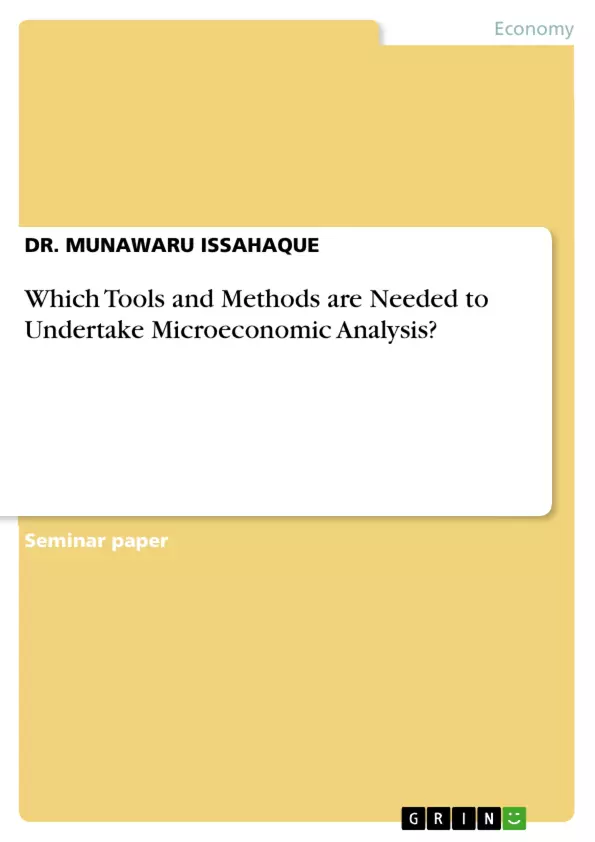This paper covers the concepts and tools needed to undertake microeconomics analysis of such problems that arise due to scarcity. The paper will also cover competitive and non-competitive product markets and why the different markets function the way they do. The researcher will attain the objectives of the course in this paper by researching on the topic and compiling not less than 15 pages. The writer will also provide a minimum of 20 multiple choice questions and answers.
Craig and Depken (2006) explained that economists endeavor to understand how people and organizations reach their decisions. They pointed out that, economists delineate different types of decision makers into three types of economic agents. From the point of view of Burkett and John (2006), “Oikonomikos” raised four issues that lie near the central problem of economics even today. These are: how limited resources are best allocated to competing needs, what a manager can do to motivate subordinates to work hard, what it takes to be a good manager and how individuals, firms and government are supposed to choose our actions when the consequences of alternative actions are uncertain.
These four issues cover the basic principles of microeconomics. Burkett and John further explained that, microeconomics overlaps with management science in its examination of optional business decisions but extend beyond that field into “normative and positive analysis of households, unions government agencies, and international trade.”. What this means is that, unlike macroeconomics which concerned itself with aggregative results of individual decisions, microeconomics analysis concerned itself with problems individuals and organizations face due to scarcity.
Inhaltsverzeichnis (Table of Contents)
- Microeconomic Analysis
- Introduction
- The Nature of Economics and its Branches
- The Concept of Scarcity
- Microeconomic Analysis in Markets
- Product Markets
- Competitive and Non-Competitive Markets
- Types of Market Structures
- Market Efficiency
- Conclusion
Zielsetzung und Themenschwerpunkte (Objectives and Key Themes)
This paper aims to provide a comprehensive analysis of microeconomics, encompassing its fundamental concepts, tools, and applications in understanding real-world economic phenomena. It examines the dynamics of markets, particularly competitive and non-competitive structures, shedding light on how market forces influence prices, production, and consumption decisions. The paper delves into the core principles of microeconomics, such as scarcity, choice, and opportunity cost, providing a theoretical foundation for analyzing market behavior and policy implications.
- Scarcity and Choice
- Market Structures and Competition
- Consumer Behavior and Demand
- Producer Behavior and Supply
- Market Efficiency and Policy Implications
Zusammenfassung der Kapitel (Chapter Summaries)
- Microeconomic Analysis: This chapter introduces the fundamental concepts of microeconomics, including scarcity, choice, and opportunity cost. It highlights the importance of microeconomic analysis in understanding individual and firm decision-making, as well as market interactions.
- Introduction: This chapter provides a brief overview of the paper's objectives, scope, and key themes. It establishes the context for the subsequent analysis of microeconomic concepts and theories.
- The Nature of Economics and its Branches: This chapter explores the nature of economics as a discipline and distinguishes between its major branches, namely microeconomics and macroeconomics. It outlines the key differences in their focus and analytical approaches.
- The Concept of Scarcity: This chapter delves into the fundamental principle of scarcity in economics, explaining its implications for resource allocation and decision-making. It discusses how scarcity drives economic choices and creates a need for efficient resource management.
- Microeconomic Analysis in Markets: This chapter examines the role of markets in allocating scarce resources and facilitating economic activity. It introduces the concept of supply and demand, explaining how market forces interact to determine prices and quantities.
- Product Markets: This chapter focuses specifically on the analysis of product markets, exploring various types of market structures, such as perfect competition, monopolistic competition, oligopoly, and monopoly. It investigates how market structure influences pricing, output, and consumer welfare.
- Competitive and Non-Competitive Markets: This chapter delves into the distinction between competitive and non-competitive markets, analyzing their characteristics, strengths, and weaknesses. It examines the role of competition in promoting efficiency and innovation.
- Types of Market Structures: This chapter provides a detailed analysis of different market structures, including perfect competition, monopolistic competition, oligopoly, and monopoly. It explores the specific features and implications of each structure for pricing, output, and consumer behavior.
- Market Efficiency: This chapter examines the concept of market efficiency, evaluating the conditions under which markets are able to allocate resources optimally. It discusses the factors that can contribute to or hinder market efficiency, such as government intervention, externalities, and information asymmetries.
Schlüsselwörter (Keywords)
The key terms and concepts explored in this paper include microeconomics, scarcity, choice, opportunity cost, market structure, competition, perfect competition, monopolistic competition, oligopoly, monopoly, supply, demand, price elasticity, consumer behavior, producer behavior, market efficiency, and government intervention.
- Citation du texte
- DR DR. MUNAWARU ISSAHAQUE (Auteur), 2013, Which Tools and Methods are Needed to Undertake Microeconomic Analysis?, Munich, GRIN Verlag, https://www.grin.com/document/490832



